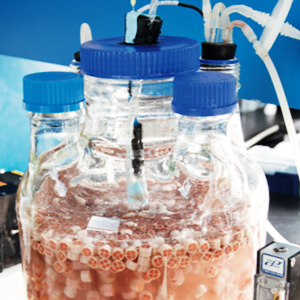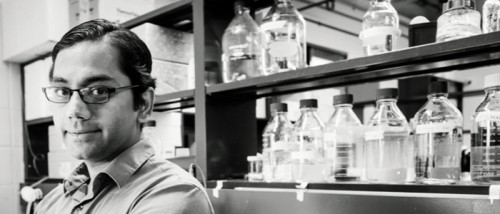Faculty Q&A: Kartik Chandran
Waste is not a dirty word to Kartik Chandran, professor of earth and environmental engineering, especially when applied to sewage, fecal sludge, or wastewater. He sees these all as enriched resources, replete with nutrients, chemicals, and energy. This past fall, Chandran was awarded a 2015 MacArthur Fellowship for his revolutionary work in transforming wastewater from a pollutant to a valuable resource and usable products like bulk chemicals and fertilizers. The “genius grant” comes with a $625,000 stipend that is given with no conditions—fellows may use the money as they see fit.
Take a tour of Chandran's lab with Mechanical Engineering Professor and former NASA astronaut Michael J. Massimino to see how bacteria are disrupting how we approach waste. (Video by Jane Nisselson)
A good thing for Chandran because his research on the global nitrogen cycle, resource recovery and reuse, and reengineering wastewater treatment has the potential to save our endangered planet from the negative impacts of climate change and resource shortages. His work has been widely recognized.
In 2011 he received a $1.5 million grant from the Bill & Melinda Gates Foundation to develop a transformative new model for water and sanitation in Africa. Chandran is focused on integrating microbial ecology, molecular biology, and engineering to transform wastewater, sewage, and other “waste” streams from problematic pollutants to valuable resources. Traditional facilities for biologically treating wastewater remove pathogens, organic carbon, and nutrients, where necessary, through decades-old technology that requires vast amounts of energy and resources, releases harmful gases into the atmosphere, and leaves behind material that must be discarded. Chandran’s approach to water sustainability investigates ways that take into account the climate, energy, and nutrient challenges we face today.
“In fact, we should remove the term ‘wastewater’ from our dictionary,” says Chandran. “To me, this is enriched water, because it’s enriched in chemicals, it’s enriched in nutrients, and it’s enriched in energy.”
We had a chance to sit down with Chandran this winter to find out what it’s like to be a noted genius and what he plans to do next.
 A highly cost-effective and energy-efficient technology for biological nitrogen removal from wastewater using anaerobic ammonia oxidizing (anammox) bacteria that is being developed by Kartik Chandran’s group (Photo by Jeffrey Schifman)
A highly cost-effective and energy-efficient technology for biological nitrogen removal from wastewater using anaerobic ammonia oxidizing (anammox) bacteria that is being developed by Kartik Chandran’s group (Photo by Jeffrey Schifman)
Q: How did you find out that you’d won the MacArthur?
A: I just came back from three hours of lecturing, and there were a few calls on my cell phone from a number I didn’t recognize. I didn’t call back, but I’m happy they did.
Q: What do you think you’ll do with the award?
A: Beyond the support from the MacArthur Foundation, it’s really a great recognition for the field of environmental engineering itself. I say this just half-jokingly: The fellowship allows us to elevate the conversation on waste to the dinner table; it makes it a bit more mainstream. And that is what’s needed if we want to really make a dent into this complex set of issues. I also think it will allow us to explore some directions that are a bit unconventional, which could potentially have a pretty significant impact on the type of work we do, and on the overall field—the field specifically being recovery and reuse of resources from “waste” or, more appropriately, enriched streams.
Q: Can you tell me more about your research area?
A: I work at the intersection of environmental microbiology, environmental molecular biology, environmental biotechnology, and environmental engineering. We are really trying to harness the power of microorganisms to do many, many things for us simultaneously. We want to achieve clean water for the masses; we want to produce clean energy; we want to convert streams that are conventionally associated with what you might call waste but I don’t! We want to have the microorganisms in the stream produce chemicals for us, and more. My approach has always been to try to understand what the organisms can do in the wastewater treatment process itself, try to understand what they are capable of, and then use process engineering techniques to coax this potential out of them. One of the implications of using the term “waste” is then we have something to remove. And we remove waste by putting in even more chemicals, more energy, more resources; and then if all goes well, we have just one thing, clean water, at the end, and yet we’ve put in so much. And when we do something like this, of course, we have three billion people on the planet who don’t have access to this model. So then the point is that we need to stop using terms such as “waste” or “wastewater.” Then we can focus on a truly science- and technology-based model for resource recovery and reuse. The implications of this model are substantial, including improved global access—not just to clean water, but, in addition, clean energy; reduced reliance on fossil resources for chemicals, nutrients; and beyond.
Q: What are some of the applications you are working on?
A: The applications that we have focused on primarily relate to improved water quality and improved human health. But my group hasn’t run after water quality in isolation, which is what researchers have done in the past. We look at water quality as one of the multiple, simultaneous end points. So we’re trying to improve water quality, but by producing a lot less greenhouse gases, by consuming substantially less energy, while at the same time producing chemicals and fuels that are far higher up on the value chain, for instance, compared to even clean water.
Sometimes, taking an approach that is opposite to conventional practice can lead to breakthrough science. That’s the case in a research partnership between Pierre Gentine and Adam Sobel. The two have collaborated to develop a new simulation strategy that more accurately models Amazon seasonal cycles. This simulation strategy gives deeper insight into the water and carbon cycles of the Amazon rain forest and better understanding of tropical climates overall.

Kartik Chandran (Photo by Tim Lee Photographers)
Q: So how do you do it?
A: Well, this is the overall challenge. We have to pick certain components; this cannot be done by me alone, even in my lifetime. This will take several generations of researchers. And even with my generation, engineers alone can’t do this. We have to work with other disciplines. I don’t consider myself to be just an engineer anymore, given that we do more molecular biology than molecular biologists themselves. The researchers in my group are a mix of engineers, chemists, biochemists, biologists, etc. My group’s philosophy is that, while all the researchers come in with different backgrounds, when they finish, they come out with a common language. And it’s not one individual language, engineering or biology, it’s a mix. This is the new face of environmental engineering; this is what is needed to be able to address such a complex set of challenges.
Q: You’ve been working with New York City for a while now.
A: Yes, it has been a privilege to work with them on real, at-scale challenges. Over a decade ago, I was part of a group involved in upgrading five of the 14 wastewater treatment plants in the city to achieve nitrogen removal. More recently, we have worked with the city on energy- and resource-efficient nitrogen removal. Such resource-efficient technologies and processes are the driving force behind a center that we are part of at Columbia. We’re also pursuing this with several other water utilities in the States and even abroad.
Q: You are very interested in cities. Why?
A: There are a lot of challenges that need to be addressed in our big cities. Right now our model of cities is that we import resources, water, energy, nutrients, chemicals, and even people. And then what happens when we are done with these things? We just take them out to the fringes and discard them. This is a linear model: use, enrich, and discard, for everything. More and more people are moving into cities. We cannot build bigger and bigger treatment plants, we cannot import more and more energy, we cannot import more and more food—we can’t do this. And so one of the directions that I’m especially passionate about—and some of our technologies here, for instance, focus on—is food waste to food, on campus at Columbia. We need to look at a distributed model for resource recovery. And cities offer the ideal palette to do this because everything is right here. The sewage is right here; the enriched streams are right here in these buildings. Why can’t we recover anything from them? Why do we need to take them somewhere, spend energy and chemicals and money to take them there, and then complain that we cannot build bigger treatment systems, centralized treatment systems? So we need a distributed model for many of these resources—water, nutrients, energy, perhaps people as well.
Q: What motivates your research?
A: I am driven by the global challenges that we face. As a society, we’ve been very good at creating problems and challenges. As an engineer, I aim to address and overcome these challenges.
